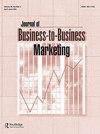毅力和情绪耗竭在销售过程中的作用
IF 2.5
4区 管理学
Q3 BUSINESS
引用次数: 1
摘要
摘要目的本文的重点是概述营销人员感兴趣的两种销售结构的现有企业对企业文献。尽管对销售文献来说相对较新,但第一个结构是坚韧。130年来,人们以各种各样的方式对这种结构进行了研究;然而,在销售文献中,这种结构在过去三年才被探索过。销售文献中研究了20多年的第二个结构是情绪耗竭,这是倦怠的三个维度之一。此外,本文还介绍了本期特刊中的八篇手稿,这些手稿扩展了市场营销对这两种兴趣结构的了解。研究意义目前在销售文献中,缺乏包含砂砾结构的研究。本文通过展示研究毅力在销售中的重要性,为营销和销售文献做出了贡献。此外,本文还讨论了最受欢迎的研究倦怠维度——情绪耗竭。尽管在销售文献中已经对情绪衰竭进行了研究,但仍需要进行更多的研究,以充分了解可能导致或导致销售人员情绪衰竭的复杂性和情况。此外,与许多未被充分探索的结构一样,如勇气,与勇气和情绪衰竭之间的关系有关的研究结果也存在不一致。因此,本文考察了这种不一致性,并提供了一些额外的研究思路供考虑。实际意义本文提请注意两个可以影响销售组织长期成功的结构。先前对这些结构中的每一个都进行了研究,强调了销售组织应该做什么和不应该做什么,以增加其销售人员的毅力并降低他们的情绪疲惫程度。这篇文章以几种有意义的方式对文学做出了贡献。首先,本文提供了以前在销售文献中发表的文章的详细表格,其中包括砂砾的结构。其次,本文研究了情绪衰竭及其在销售过程中的作用。还简要讨论了毅力如何影响情绪衰竭。最后,基于先前的研究以及从本期特刊中的八篇文章中收集到的见解,提出了未来的研究机会和建议。本文章由计算机程序翻译,如有差异,请以英文原文为准。
The Role of Grit and Emotional Exhaustion in the Selling Process
ABSTRACT Purpose The focus of this article is to provide an overview of the existing business-to-business literature on two sales constructs that have been of interest to marketers. Although relatively new to the sales literature, the first construct is grit. This construct has been studied in a wide variety of manners for 130 years; however, within the sales literature, this construct has only been explored for the past three years. The second construct has been investigated in the sales literature for over 20 years is emotional exhaustion, which is one of the three dimensions of burnout. Furthermore, this article then introduces the eight manuscripts included in this special issue which expand marketing’s knowledge on these two constructs of interest. Research Implications Currently in the sales literature, there is a lack of research containing the grit construct. This article contributes to the marketing and sales literature by showcasing the importance of researching grit in sales. In addition, this article discusses the most popular researched burnout dimension, emotional exhaustion. Although emotional exhaustion has been studied in the sales literature, there is still additional research needed in order to fully understand the intricacies and situations that might lead to or result from a salesperson’s experiencing emotional exhaustion. Further, as with many underexplored constructs, such as grit, there is also an inconsistency in the research findings related to the relationship between grit and emotional exhaustion. Therefore, this article examines this inconsistency and provides some additional research ideas for consideration. Practical Implications This article calls attention to two constructs that can impact a sales organization’s long-term success. Prior research on each of these constructs is provided which highlights what a sales organization should and should not do in order to increase grittiness and reduce emotional exhaustion levels of their salesforce. Originality/Value/Contribution This article contributes to the literature in several meaningful ways. First, this article provides a detailed table of articles previously published in the sales literature that include the construct of grit. Second, this article investigates emotional exhaustion and its role in the sales process. A brief discussion on how grit might impact emotional exhaustion is also provided. Finally, based on prior research as well as insights gleaned from the eight articles included in this special issue, future research opportunities and suggestions are presented.
求助全文
通过发布文献求助,成功后即可免费获取论文全文。
去求助
来源期刊
CiteScore
2.20
自引率
35.70%
发文量
22
期刊介绍:
The Journal of Business-to-Business Marketing® encourages diversity in approaches to business marketing theory development, research methods, and managerial problem solving. An editorial board comprised of outstanding, internationally recognized scholars and practitioners ensures that the journal maintains impeccable standards of relevance and rigorous scholarship. The Journal of Business-to-Business Marketing features: •basic and applied research that reflects current business marketing theory, methodology, and practice •articles from leading researchers covering topics of mutual interest for the business and academic communities

 求助内容:
求助内容: 应助结果提醒方式:
应助结果提醒方式:


